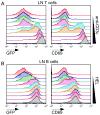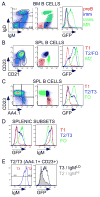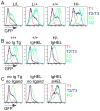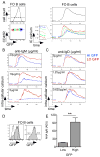Endogenous antigen tunes the responsiveness of naive B cells but not T cells
- PMID: 22902503
- PMCID: PMC3438375
- DOI: 10.1038/nature11311
Endogenous antigen tunes the responsiveness of naive B cells but not T cells
Abstract
In humans, up to 75% of newly generated B cells and about 30% of mature B cells show some degree of autoreactivity. Yet, how B cells establish and maintain tolerance in the face of autoantigen exposure during and after development is not certain. Studies of model B-cell antigen receptor (BCR) transgenic systems have highlighted the critical role of functional unresponsiveness or ‘anergy’. Unlike T cells, evidence suggests that receptor editing and anergy, rather than deletion, account for much of B-cell tolerance. However, it remains unclear whether the mature diverse B-cell repertoire of mice contains anergic autoreactive B cells, and if so, whether antigen was encountered during or after their development. By taking advantage of a reporter mouse in which BCR signalling rapidly and robustly induces green fluorescent protein expression under the control of the Nur77 regulatory region, antigen-dependent and antigen-independent BCR signalling events in vivo during B-cell maturation were visualized. Here we show that B cells encounter antigen during development in the spleen, and that this antigen exposure, in turn, tunes the responsiveness of BCR signalling in B cells at least partly by downmodulating expression of surface IgM but not IgD BCRs, and by modifying basal calcium levels. By contrast, no analogous process occurs in naive mature T cells. Our data demonstrate not only that autoreactive B cells persist in the mature repertoire, but that functional unresponsiveness or anergy exists in the mature B-cell repertoire along a continuum, a fact that has long been suspected, but never yet shown. These results have important implications for understanding how tolerance in T and B cells is differently imposed, and how these processes might go awry in disease.
Figures




Comment in
-
B cell signalling: Discouraging encounters.Nat Rev Immunol. 2012 Oct;12(10):680-1. doi: 10.1038/nri3305. Epub 2012 Sep 7. Nat Rev Immunol. 2012. PMID: 22955847 No abstract available.
References
Publication types
MeSH terms
Substances
Grants and funding
LinkOut - more resources
Full Text Sources
Other Literature Sources
Molecular Biology Databases

